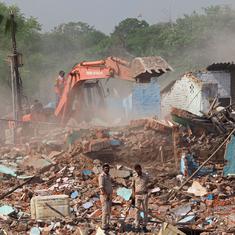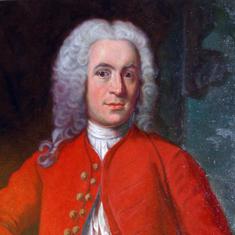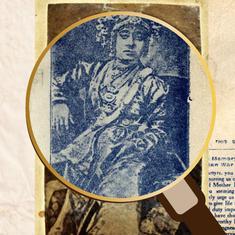JNU violence: ABVP member admitted on camera that he planned attack, claims India Today sting
RSS-linked students’ organisation denies that man caught of camera is associated with it.

Five days after a masked mob attacked students and teachers at Jawaharlal Nehru University, injuring 34 of them, India Today claimed on Friday that it had identified one of the assailants as being a member of the Akhil Bharatiya Vidyarthi Parishad.
The ABVP is the students’ wing of the Rashtriya Swayamsevak Sangh, the ideological parent of the ruling Bharatiya Janata Party.
In clips recorded by the news channel’s “Special Investigation Team” on hidden cameras, ABVP member Akshat Awasthi, a first-year student of the French degree programme at JNU, identified himself as one of the attackers. Awasthi showed the channel a video of himself rushing through the corridors as he wears a helmet and carries a stick.
“What did you have in your hand?” an undercover reporter for the channel asked Awasthi. “It was a stick, sir. I pulled it out from a flag lying near [the] Periyar [hostel],” Awasthi answers.
Asked if he had hit anyone, Awasthi said he attacked a man with a “flowing beard, who looked like a Kashmiri”.
“I come from an area in Kanpur where goondas [goons] are common in every street,” Awasthi said. “I used to watch them.”
The attack left more than 30 students and teachers injured. The masked mob also damaged property and vehicles.
The ABVP tweeted to deny that Awasthi is associated with the organisation.
Akshat Awasthi is neither an office bearer, nor a karyakarta of ABVP, as claimed by @IndiaToday. This is a smear campaign run by India Today to deviate everyone from the facts put forth by @DelhiPolice proving #LeftBehindJNUVoilence.
— ABVP (@ABVPVoice) January 10, 2020
- National General Secretary @nidhitripathi92
Awasthi said the attack was carried out as revenge for an attack that Left students had allegedly carried out on some ABVP residents of the Periyar hostel earlier in the day.
Awasthi claimed to India Today that he mobilised all the members of the mob. He said he was able to do so by calling up an organisational secretary of the ABVP, who lived outside the main JNU campus. “Left-wing students and teachers were holding a meeting at Sabarmati [hostel],” he said.
Recounting how the mob smashed vehicles and furniture on a street facing the Sabarmati hostel, Awasthi said on camera that the students and teachers at the meeting ran away when the attack began. “They had no idea that the ABVP would ever retaliate like this,” he boasted.
Asked if 20 ABVP activists were students of the university and 20 others were mobilised from outside, the student replied that he organised the operation. “They don’t have that much mind,” he said of the attackers. “You know you need to act like a superintendent or a commander. Why it’s to be done and where exactly. I guided them about everything – where to hide, where to go. I told them to do everything systematically.”
Awasthi told India Today that he had “channelled their anger in the right direction”.
Awasthi said that the police were already inside the campus when the attack began, as he had called them after the attack on Periyar hostel. The ABVP leader claimed to the team that one police officer encouraged the mob to beat up students affiliated to Left organisations.
Awasthi also claimed that the police ordered the power cut during the attack as they did not want people to know that the mobilisation was taking place. Asked why the mob covered their faces, Awasthi said it was a tactic the ABVP adopted from the Left attacks on campus.
Rohit Shah, a colleague of Awasthi, said on camera that he had given his helmet to the ABVP leader. Shah said that the helmet was vital protection while breaking glass. Asked if he was proud of the violence, Shah said: “Of course, of course.” He claimed that if the attack had not been carried out in that manner, the Left would not have realised the strength of the Rashtriya Swayamsevak Sangh-affiliated organisation. “We copied it. The Left came with the masks. So, we said let’s be masked.”
JNU Vice Chancellor Jagadesh Kumar had told India Today in an interview that the January 5 attack had its roots in the events that had unfolded on campus the day before. Kumar alleged that a masked mob entered the campus on January 4 and took control of the data centres in the university.
Former JNU Students’ Union president admits attack on servers
The Delhi Police had on January 5 registered two first information reports against 26 students, including JNU Students’ Union President Aishe Ghosh, for allegedly damaging a computer server room on January 1 and 4. Ghosh has denied that she had anything to do with the attack. Video clips on Sunday showed Ghosh with a profusely bleeding head. She received 16 stitches for her wounds. Her left hand was fractured.
However, as part of its investigation, India Today also reported that former JNU Students’ Union president and Left activist Geeta Kumari admitted that she was part of the attack on the server room on January 4. She said the servers were shut down because the vice chancellor had not met them to address their demands. The server rooms were shut to prevent the administration from functioning, Kumari said.
JNU students have been protesting for two months over increases in hostel and mess fees. Though the administration partially rolled back the increases, the protests continued. Ghosh had said in an interview to NDTV that the JNU Students’ Union has decided to boycott the semester registration process.
The Delhi Police on Friday said they have identified nine people as the attackers in connection with the violence on the campus on January 5. The suspects include Ghosh. The police alleged that Ghosh and several others attacked students at Periyar Hostel last week. Specific rooms were targeted at the hostel, they claimed.
The police released photographs of the alleged attackers and identified them as Chunchun Kumar, Pankaj Mishra, Waskar Vijay, Sucheta Talukdar, Priya Ranjan, Dolan Samanta, Yogendra Bhardwaj and Vikas Patel. Seven of these people were from the Left-backed All India Students Association and two from the ABVP. However, the police has not yet made any arrests in connection with the attack.









